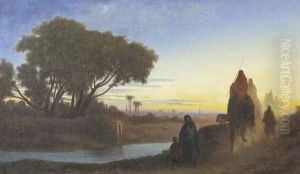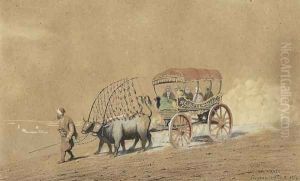Charles-Theodore Frère Paintings
Pierre Edouard Frère, often known as Charles-Théodore Frère, was born on June 21, 1814, in Paris, France. He was a distinguished 19th-century French painter renowned for his Orientalist works and depictions of Middle Eastern landscapes and scenes, which reflected European fascination with exotic cultures during that era.
Frère received his early artistic training under the guidance of Camille Roqueplan and later worked with Paul Delaroche, two prominent French painters of the time. His formal education at the École des Beaux-Arts in Paris provided him with the foundational skills and techniques that would shape his artistic career.
Frère's travels to the Middle East, particularly Egypt and Algeria, were central to the development of his artistic themes and style. He was captivated by the region's vibrant light, rich colors, and the daily lives of its people. His journeys began in the 1830s, a period when Orientalist art was gaining popularity among European audiences. This genre of art focused on portraying the Middle East and North Africa with a romanticized, often exoticized perspective, which appealed to the European imagination.
Throughout his career, Frère exhibited his works at the prestigious Paris Salon, the official art exhibition of the Académie des Beaux-Arts. His paintings were well-received, and he gained considerable recognition for his contributions to the Orientalist movement. He was awarded several medals at the Salon and was eventually bestowed with the Legion of Honor, France's highest order of merit for military and civil distinctions, in recognition of his artistic achievements.
Frère's work often depicted everyday life in the Middle East, from bustling bazaars to serene landscapes. He was adept at capturing the intricate details of architecture and costume, imbuing his scenes with authenticity and a sense of place. Despite the sometimes idealized nature of Orientalist art, Frère's attention to detail and his genuine fascination with his subjects lent a degree of respect and empathy to his portrayals.
Charles-Théodore Frère continued to paint and exhibit throughout his life, leaving behind a legacy of works that contribute to our understanding of 19th-century European perceptions of the Middle East. He passed away on March 24, 1888, in Paris, having enriched the world of art with his extensive and evocative body of work that continues to be studied and appreciated by art historians and enthusiasts alike.

